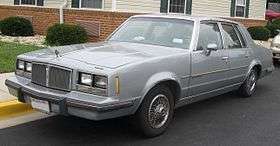GM G platform (1969)
- See also: GM A platform (RWD)
| General Motors G Platform | |
|---|---|
 | |
| Overview | |
| Manufacturer | General Motors |
| Production | 1978–1988 |
| Body and chassis | |
| Class | Mid-size |
| Body style(s) |
4-door sedan 2-door coupe 4-door station wagon 2-door coupé utility pickup |
| Chronology | |
| Predecessor | GM A platform (RWD) |
| Successor |
GM A platform (FWD) GM W platform GM H platform (FWD) |
The General Motors G platform (also called G-body) was an automobile platform designation used for mid-sized rear wheel drive cars first from 1969-1972 and again from 1982 to 1988. The G-body models began production designated as A-body cars in 1978, but were redesignated as G when the new front wheel drive A-body was introduced in 1982
The G-body designation was originally used for 1969–1972 Pontiac Grand Prix and 1970–1972 Chevrolet Monte Carlo personal luxury coupes.
Between 1973 and 1981 the A-body coupes with formal rooflines were designated as A-Special and after 1982 dubbed as the G-Special. These special coupes included Monte Carlo, Grand Prix, Oldsmobile Cutlass Supreme and Buick Regal two door models. The 1978 model year being the changeover year between the larger 73-77 body style and the reborn A/G platform. The Cutlass Supreme chassis being named an A body until GM changed the name into the official G body platform even though they were near identical, in 1981.
At some point in the platform's lifetime, the term "G-Body Shuffle" became popular in the drag racing community (where the cars were often modified for racing) for the vehicle's side-to-side motion of the rear end after taking off from the starting line. This was due to the car's triangulated four-link rear end suspension, which caused uneven torque to the rear wheels under strenuous driving.
In 1982, the Chevy Malibu/Pontiac LeMans coupes were dropped along with the Buick/Olds fastbacks. 1983 was the last year for wagons and Chevy Malibu sedans, leaving the G-Special coupes, B-O-P formal-roof sedans and the Chevy El Camino/GMC Caballero. In 1988, most remaining G-body models were moved to the new front wheel drive GM W platform, although the Pontiac Bonneville moved to the H-body, the El Camino was dropped without replacement and there would be a one-year gap before the W-body Chevy Lumina coupe truly replaced the Monte Carlo. GM later used the GM G platform (FWD) designation for unrelated full-sized cars.
G-bodies were some of the last cars to follow the classic muscle car formula, remaining popular while most mid-sized cars moved to front wheel drive. They were also raced in NASCAR.
Vehicles

This family consisted of:
- Buick Regal (1978–1987)
- Chevrolet El Camino (1978–1987)
- Chevrolet Malibu (1978–1983)
- Chevrolet Monte Carlo (1978–1988)
- GMC Caballero (1982–1987)
- Oldsmobile Cutlass Supreme (1978–1988) note: 1988 model known as Cutlass Supreme Classic
- Oldsmobile Cutlass Cruiser (1982–1983)
- Oldsmobile Cutlass Salon (1986–1987)
- Pontiac Bonneville (1982–1986)
- Pontiac Grand Prix (1978–1987)
Performance vehicles
Performance applications include:
- 1982 Buick Regal Sport Coupe 3.8 L (231 in³) V6 Turbo
- 1982–1987 Chevrolet El Camino SS 5.0 L (305 in³)/5.7L (350 in³) V8
- 1983–1984 Oldsmobile Hurst/Olds 5.0 L (307 in³) HO V8
- There is also speculation that 3 Hurst/Olds editions were made using 1988 Cutlass Supreme Classic bodies. These were not marketed through GM though. There was also a Hurst/Olds body kit available in 1988.
- 1978 Oldsmobile Hurst/Olds 5.7 L (350 in³) Olds Rocket 350
- 1983–1988 Chevrolet Monte Carlo SS 5.0 L (305 in³) HO V8
- 1983–1986 Buick Regal T-Type 3.8 L (231 in³) V6 Turbo
- 1982, 1984–1987 Buick Grand National 3.8 L (231 in³) V6 Turbo
- 1985–1987 Oldsmobile 442 5.0 L (307 in³) HO V8
- 1986–1987 Chevrolet Monte Carlo SS Aerocoupe 5.0 L (305 in³) HO V8
- 1986.5 Pontiac Grand Prix 2+2 5.0 L (305 in³) V8
- The 1986.5 Grand Prix 2+2 cosmetic features which included a NASCAR qualifying nose-cone was also available through GM for installation on any 1981–1987 Grand Prix. There were 17 Grand Prix GTs offered by Myrtle Motors in New York which offered a slightly different look and had some performance tuning in 1986.
- 1987 Buick Regal T Turbo 3.8 L (231 in³) V6 Turbo
- 1987 Buick Regal T (307 in³)
- 1987 Buick Regal many base and Limited models featured the 3.8 L (231 in³) V6 Turbo
- 1987 Buick GNX 3.8 L (231 in³) V6 Turbo
- The 1987 GNX was made in conjunction with ASC/McLaren and 547 were made and included a unique suspension system, featured fender flares, had Stewart-Warner gauges,Bigger Garret Turbo and intercooler, and a net power of 276 hp (206 kW), above the 245 hp (183 kW) of the regular Grand National. There are many more features that set the GNX apart and are too many to list.
External links
- GBodyParts.com - #1 GBody Part Supplyer
- GBodyLED - Modernize Your Vehicle Lighting.
- G-Body forum and information
- The Original G-Body central information hub
- GBodyForum.com -- '78-'88 GM A/G Body Community
- OldsGmail.com - Home of the Oldsmobile G-Body Mailing List
- GBodies.com - Devoted to the GM G Bodies
- List of GM VIN codes